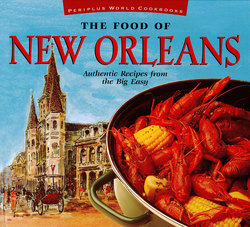Читать книгу The Food of New Orleans - John DeMers - Страница 5
На сайте Литреса книга снята с продажи.
ОглавлениеPart One: Food in New Orleans
On the foundations of Creole and Cajun cooking, a city builds a temple to terrific food
by John DeMers
Lavishly festooned with magnolia and bougainvillea, New Orleans is an American city unlike any other. This steamy Southern metropolis is well loved for its charming architecture, its music—especially jazz—and its riotous Mardi Gras celebration. Yet most of all, it is revered for its food.
The city's unique history—it was founded by French colonists in the eighteenth century—and location at the mouth of the Mississippi River have given it a personality all its own. Its French roots may be why New Orleanians are known for their love of good food—nowhere else will you find so many famous dishes: gumbo, crawfish étouffée, jambalaya, muffuletta sandwiches—the list goes on.
Situated at the mouth of the largest and most important waterway in America, New Orleans has welcomed immigrants from around the world. And its food reveals the contributions of the city's many peoples—not only the first French and Spanish colonists, the Creoles (descendants of French, Spanish, African, and Caribbean colonists), and the Cajuns (French-Canadian immigrants who arrived in the eighteenth century), but also West Indians, Germans, Italians, Chinese, and Thais, to name a few.
No other American city can boast an unbroken tradition of fine dining as long as that of New Orleans; its classic French cuisine can be sampled in dining rooms that are over 150 years old. At the same time, it's hard to think of any other American city that has undergone such dramatic culinary change in one generation, evolving from a place that once scorned any food not its own into a city that now embraces dishes and cooking techniques from around the world.
This new spirit has reinvigorated New Orleans cuisine, which had become somewhat frozen in time. In recent years the old dynastic restaurant system, in which chefs handed down their recipes from generation to generation, has been challenged by a new breed of eateries built around a single innovative chef-owner's vision. The result has been change, growth, diversity, and excitement.
What New Orleans cuisine is about today is surprise. Just when you expect a classic dish unchanged from its roots, the one put before you could be straight out of the trendiest food magazine—next month's edition, no less. And just when you think these young chefs have gone crazy, out comes the most glorious traditional Creole courtbouillon or Cajun cochon de lait. There is no way to predict; there are only ways to enjoy.
This book is about the mystery and magic of New Orleans cooking. It explores the flavors of the city's intermingled cultures, the shifts and slants of its rich history, and its deep spirit of celebration.
